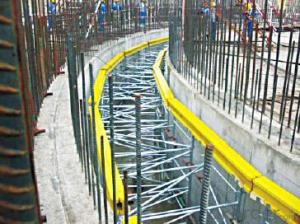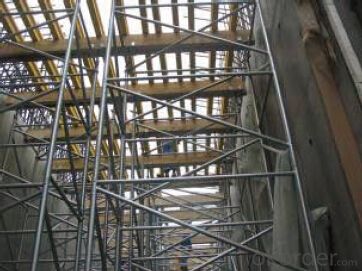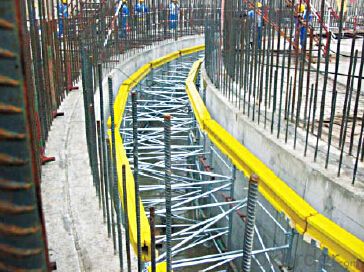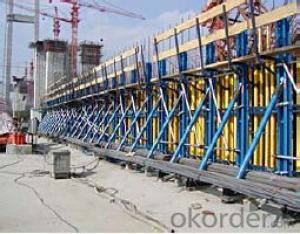Tower Scaffolding for Formwork and Scaffolding Systems
- Loading Port:
- Tianjin
- Payment Terms:
- TT OR LC
- Min Order Qty:
- 50 m²
- Supply Capability:
- 1000 m²/month
OKorder Service Pledge
Quality Product, Order Online Tracking, Timely Delivery
OKorder Financial Service
Credit Rating, Credit Services, Credit Purchasing
You Might Also Like
Tower Scaffolding
Shoring tower is an effective supporting system. It is easy to assemble and dismantlement, and
has excellent stability and bearing capacity. It has been widely used in the construction of industry
& residential buildings , bridges, tunnels and dam project, etc.
Characteristics:
◆ High degree of standardization.
◆ Easy storage and transportation
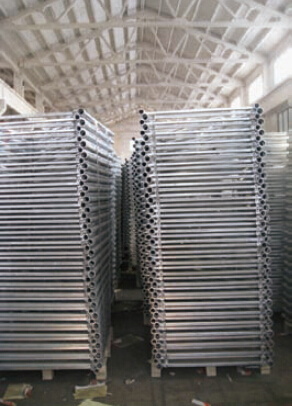
- Q: What are the advantages and disadvantages of the application of the steel formwork and the plywood formwork in the construction?
- Economic aspect: the steel formwork one-time investment cost is high, but the turnover number is more; the wood template cost is low, but the turnover number is less
- Q: How does steel formwork accommodate for different concrete curing methods?
- Steel formwork can accommodate different concrete curing methods by providing a sturdy and adjustable framework that can be easily repositioned or modified to suit the specific requirements of the curing process. This allows for various curing methods such as wet curing, air curing, or accelerated curing to be implemented without compromising the integrity of the formwork structure. Additionally, steel formwork can be designed to incorporate features like built-in insulation or heating elements, further enabling it to adapt to specific curing methods and optimize the concrete curing process.
- Q: Can steel formwork be used for curved or complex structures?
- Indeed, curved or intricate structures can be constructed using steel formwork. The employment of steel formwork provides abundant flexibility and adaptability, rendering it well-suited for fashioning diverse shapes and designs. Its robustness and sturdiness enable it to maintain its form, even when employed in curvilinear or intricate structures. Moreover, steel formwork can be conveniently fabricated and modified to meet particular project specifications, rendering it a perfect selection for erecting complex designs.
- Q: How does steel formwork impact the overall sustainability of a project?
- The overall sustainability of a project can be significantly influenced by the use of steel formwork. Firstly, steel is an incredibly durable material that can withstand repeated use, allowing the formwork to be reused multiple times before reaching the end of its life cycle. This reusability reduces the need for frequent replacements, thereby minimizing material consumption and waste generation during construction. Furthermore, steel formwork is renowned for its strength and structural stability, enabling the construction of robust and long-lasting structures. This means that buildings constructed with steel formwork are more likely to have a longer lifespan, reducing the necessity for frequent renovations or demolitions. As a result, this leads to a decrease in resource consumption and the associated carbon emissions that accompany new construction. Additionally, steel is a highly recyclable material, and steel formwork can be easily recycled at the end of its life cycle. The recycling process of steel requires less energy compared to the production of new steel, thereby reducing the project's carbon footprint. By choosing steel formwork, construction projects can contribute to the circular economy by promoting the use of recycled materials and diminishing landfill waste. Moreover, steel formwork offers improved efficiency in construction processes. Its modular nature and ease of assembly make it a time-saving option, reducing construction time and, consequently, the energy consumption required for on-site operations. The expedited construction process also minimizes disruption to the surrounding environment, lessening the overall environmental impact of the project. Lastly, steel formwork can enhance the overall sustainability of a project by providing a safer working environment for construction workers. Its strength and stability ensure that the formwork remains secure during concrete pouring, reducing the risk of accidents and injuries. This promotes the well-being of workers and aligns with the principles of social sustainability. In conclusion, the use of steel formwork has a positive impact on the overall sustainability of a project. Its durability, reusability, and recyclability contribute to resource conservation, reduction in carbon emissions, and long-term viability of structures. By opting for steel formwork, construction projects can advance sustainability objectives and contribute to a more environmentally and socially responsible built environment.
- Q: Is steel formwork resistant to corrosion?
- Yes, steel formwork is generally resistant to corrosion. Steel, particularly stainless steel, is known for its high resistance to corrosion, making it a suitable choice for construction applications. However, it is important to note that the extent of corrosion resistance can depend on factors such as the grade of steel used, the environment in which the formwork is used, and the presence of any additional protective coatings. Regular maintenance and proper care can also help prolong the lifespan and corrosion resistance of steel formwork.
- Q: Can steel formwork be used for both interior and exterior concrete finishes?
- Yes, steel formwork can be used for both interior and exterior concrete finishes. Steel formwork is known for its strength and durability, making it suitable for a variety of applications. Whether it is for interior walls, columns, or exterior slabs, steel formwork provides a smooth and consistent surface for the concrete to be poured into. Additionally, steel formwork can be easily customized and adjusted to meet specific project requirements, making it a versatile choice for both interior and exterior concrete finishes.
- Q: Can steel formwork be used for marine construction projects?
- Yes, steel formwork can be used for marine construction projects. Steel is a durable material that can withstand harsh marine conditions, including exposure to saltwater, waves, and corrosive elements. Steel formwork provides the required strength and stability to withstand the forces exerted by the marine environment. It can be used for various marine construction applications, such as building seawalls, piers, jetties, and offshore structures. Additionally, steel formwork offers advantages such as easy assembly and disassembly, reusability, and the ability to create complex shapes and structures. However, proper corrosion protection measures, such as galvanization or the use of anti-corrosive coatings, should be implemented to ensure the longevity and performance of the steel formwork in marine environments.
- Q: Is steel formwork suitable for all types of construction projects?
- Steel formwork, a construction material widely used and known for its versatility, may not be appropriate for all types of construction projects. The advantages of steel formwork are numerous, including its durability, reusability, and high load-bearing capacity. It can be utilized for both large and small projects, including residential, commercial, industrial, and infrastructure endeavors. Steel formwork is especially well-suited for projects that demand precision and a high-quality finish, such as high-rise buildings, bridges, and tunnels. However, several factors need to be considered when determining if steel formwork is suitable for a particular construction project. One crucial factor is the budget allocated to the project. Steel formwork generally has a higher initial cost compared to alternative formwork materials like timber or aluminum. As a result, it may not be the best choice for projects with tight budget constraints. Another factor to take into account is the project's timeline. Assembling, disassembling, and transporting steel formwork requires skilled labor and time. This can lead to longer construction periods, which may not be feasible for projects with strict deadlines. The complexity of the project is also an important consideration. While steel formwork can be customized to meet specific project requirements, constructing it for projects with irregular or complex shapes may be more challenging and time-consuming compared to other formwork materials. Additionally, the environmental conditions of the construction site should be evaluated. Steel formwork is durable and able to withstand harsh weather conditions. However, it may not be appropriate for projects in coastal areas or locations with high humidity, as steel is susceptible to corrosion. In conclusion, the suitability of steel formwork for a construction project should be evaluated on a case-by-case basis. Factors such as budget, timeline, complexity, and environmental conditions should all be taken into consideration to determine if steel formwork is the most suitable option.
- Q: What are the considerations when designing steel formwork for elevated walkways?
- When designing steel formwork for elevated walkways, there are several important considerations to take into account. These considerations include structural integrity, safety, durability, and ease of installation. Firstly, the structural integrity of the formwork is crucial. The design must be able to support the weight of pedestrians and any additional live loads such as equipment or furnishings. The formwork should be designed to withstand any potential deflection or deformation, ensuring a stable and secure walkway. Safety is another paramount consideration. The formwork should have adequate handrails and guardrails to prevent falls and provide a safe environment for pedestrians. It is important to comply with relevant safety standards and regulations to minimize the risk of accidents or injuries. Durability is also a key consideration when designing steel formwork for elevated walkways. The materials used should be able to withstand exposure to environmental factors such as weather, temperature changes, and corrosion. Proper surface treatments and coatings can help enhance the durability of the formwork, extending its lifespan and reducing maintenance requirements. Additionally, ease of installation is an important factor to consider. The formwork should be designed in a way that allows for efficient and straightforward installation, minimizing construction time and costs. Modular designs or pre-fabricated components can help simplify the installation process and ensure consistency in the final structure. Furthermore, it is essential to consider accessibility and inclusivity when designing steel formwork for elevated walkways. The design should accommodate individuals with disabilities, providing appropriate ramps, handrails, and tactile indicators to ensure equal access for all users. Lastly, it is crucial to engage with experienced professionals such as structural engineers and architects during the design process. Their expertise and knowledge can help ensure that all necessary considerations are taken into account, resulting in a well-designed and functional steel formwork for elevated walkways.
- Q: Can steel formwork be used for tunnel construction?
- Tunnel construction can make use of steel formwork, which are molds made from steel that shape and support concrete during the building process. Steel formwork is commonly employed in tunnel construction to create the tunnel lining. This lining provides both structural support and protection from external forces. The use of steel formwork in tunnel construction offers several advantages. Firstly, steel formwork possesses strength and durability, making it capable of withstanding the pressures and forces exerted on the tunnel structure. As a result, it is suitable for constructing tunnels in various ground conditions, including soft soils, rock, or even underwater. Secondly, steel formwork is highly customizable, allowing for flexibility in tunnel design. It can be prefabricated off-site and then assembled on-site, reducing both construction time and costs. Moreover, steel formwork can be reused, enhancing its cost-effectiveness and sustainability. Furthermore, steel formwork provides a smooth and high-quality finish to the tunnel lining. This ensures the structural integrity and longevity of the tunnel. Additionally, it allows for the easy installation of other tunnel components, such as electrical conduits, ventilation systems, and drainage pipes. However, it is important to consider various factors when selecting the appropriate formwork material, including tunnel dimensions, construction method, ground conditions, and project requirements. Depending on the specific needs of the project, materials such as timber or aluminum may also be suitable for tunnel construction.
Send your message to us
Tower Scaffolding for Formwork and Scaffolding Systems
- Loading Port:
- Tianjin
- Payment Terms:
- TT OR LC
- Min Order Qty:
- 50 m²
- Supply Capability:
- 1000 m²/month
OKorder Service Pledge
Quality Product, Order Online Tracking, Timely Delivery
OKorder Financial Service
Credit Rating, Credit Services, Credit Purchasing
Similar products
Hot products
Hot Searches
Related keywords

